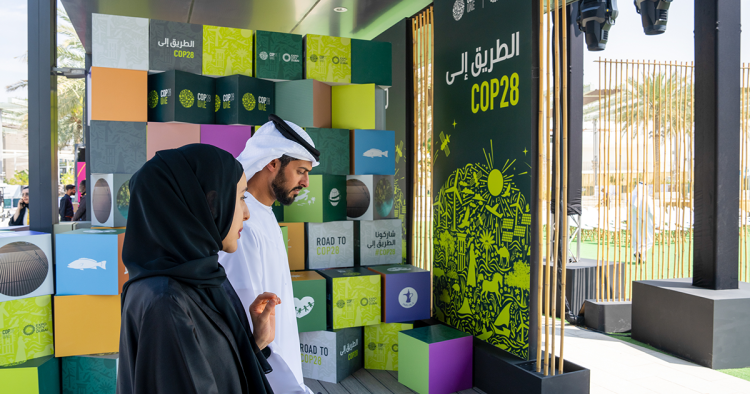In the race to manage climate change, the United Arab Emirates is ramping up efforts to accelerate its transition to a green economy. In the first two weeks of July 2023, the UAE published several important documents laying out its actions and objectives, including a revised version of the national climate pledges it made under the Paris Agreement, known as the Third Update of the Second Nationally Determined Contribution (NDC), alongside a number of targeted policies and strategies, namely the UAE Hydrogen Strategy, the National Energy Strategy, and (at an emirate level) the Abu Dhabi Climate Change Strategy.
Third updated NDC
The new NDC update builds on the UAE’s previous one, submitted in September 2022 as a response to the Glasgow Climate Pact reached at the 2021 United Nations Climate Change Conference (Conference of the Parties, COP), which laid out its objective of reducing total greenhouse gas emissions by 18% as compared to the business-as-usual (BAU) level. Although the UAE is designated as a non-Annex 1 country, or developing nation, under the U.N. Framework Convention on Climate Change, that does not prohibit it from taking further steps to enhance its emission reduction targets.
The third updated NDC sets an absolute emission reduction target, moving away from BAU scenarios to minimize the level of associated uncertainty. The new methodology adapts the year 2019 as a baseline for its national and sectoral reduction targets. This is meant to enhance transparency, since the UAE’s economy and population have grown in recent years, most likely resulting in a peak in emissions between 2019 and 2023.
The new NDC update also revises the targeted emission reduction from an expected 208 metric tons of carbon dioxide equivalent (MtCO2e) to 182 MtCO2e. This could be translated as a 40% reduction compared to the 30% reduction laid out in the second updated NDC (BAU), and a 19% target emission avoidance with the revised methodology (i.e., using a base year instead of BAU).
A roadmap for comprehensive sectoral plans, policy frameworks, and national-, emirate- and company-level programs to support the implementation of the proposed targets has also been laid out as well.
UAE National Energy Strategy 2050
Reinforcing the sectoral targets, especially for major economic sectors like energy, which accounts for nearly 80% of the total emitted CO2-equivalent in the UAE, necessitated a more detailed plan, the UAE National Energy Strategy 2050. This strategy is essential to achieving the latest NDC’s objective of reducing the power grid emission coefficient (of 51%) as compared to the 2019 base year. The strategy seeks to boost the share of clean energy in the UAE’s total energy mix to 30% by 2031 and thus triple the contribution of renewable energy by 2030. This is likely to create new investment opportunities as the strategy aims to realize savings of up to AED 100 billion ($27.23 billion) and increase national energy investments by up to AED 150 billion-200 billion ($40.84 billion-54.45 billion) when delivered.
With respect to these policies and strategies, it’s clear that the UAE is determined to not only boost its capacity to provide clean and sustainable energy but also to strengthen its competitiveness in producing and exporting clean fuels, just as it has played a leading role in the oil and natural gas export market in the previous decades.
UAE Hydrogen Strategy
Complementing the National Energy Strategy and following on the announcement of the Hydrogen Leadership Roadmap in 2021, the UAE Hydrogen Strategy was simultaneously announced earlier in July. The strategy aims to foster innovation and facilitate the country’s energy transition by providing the right ecosystem for low-carbon hydrogen projects. The UAE has already moved forward with this effort, and its strategy is being underpinned by seven projects on the ground, pilot developments, and four test cargos sold to generate new sources of value, with a particular emphasis on oil refining processes and ammonia, power storage, heat and steel industries, heavy transport, as well as derivatives exports. As a result, new alliances and partnerships would be formed and new investors sought to take part in the country’s energy transition process, recognizing the UAE’s favorable geographic positioning to serve as a future low-carbon hydrogen hub.
Local strategies
In addition to the national efforts to accelerate climate action, each of the UAE’s seven emirates is introducing its own local strategies to help achieve climate neutrality and realize the country’s net-zero ambitions. For instance, Abu Dhabi has announced its Climate Change Strategy, signed by Crown Prince Sheikh Khaled bin Mohamed bin Zayed in July. The collective efforts and contributions of the emirates are all part of a long-term national program to balance environmental and climate objectives while supporting the economy by ensuring the sustainability of natural resources for future generations.
Outlook
As the UAE prepares to host COP28 this fall, the country is paving the way for climate action by taking a variety of measures to foster the energy transition and achieve net-zero goals. Such an approach should help mobilize international efforts to slash emissions through innovative and holistic solutions to decarbonize oil and deploy clean technology and development financing, all of which could yield benefits that last well beyond the UAE’s COP28 presidency.
Athra Khamis is a non-resident scholar with the Climate and Water Program at the Middle East Institute and a climate change analyst at the UAE Ministry of Climate Change and Environment. Her areas of expertise include climate change scenarios, atmospheric composition, water resource analysis, environmental ecosystems, and sustainability
Photo by Waleed Zein/Anadolu Agency via Getty Images.
The Middle East Institute (MEI) is an independent, non-partisan, non-for-profit, educational organization. It does not engage in advocacy and its scholars’ opinions are their own. MEI welcomes financial donations, but retains sole editorial control over its work and its publications reflect only the authors’ views. For a listing of MEI donors, please click here.













